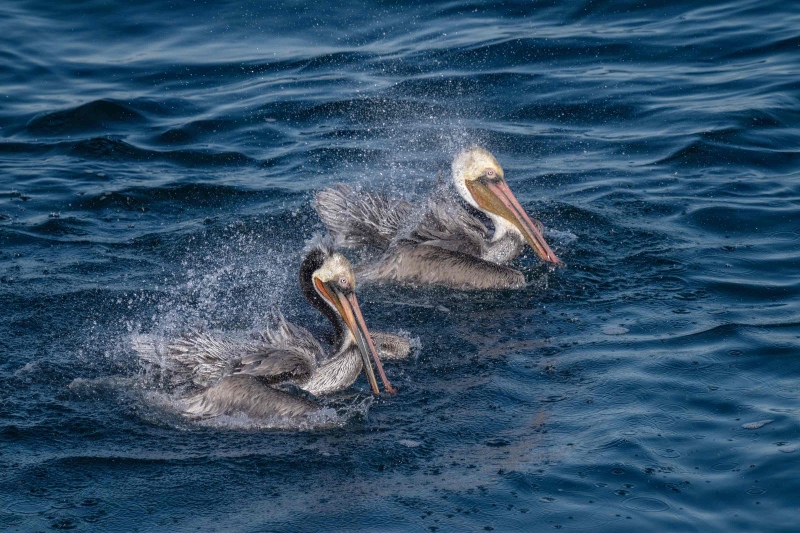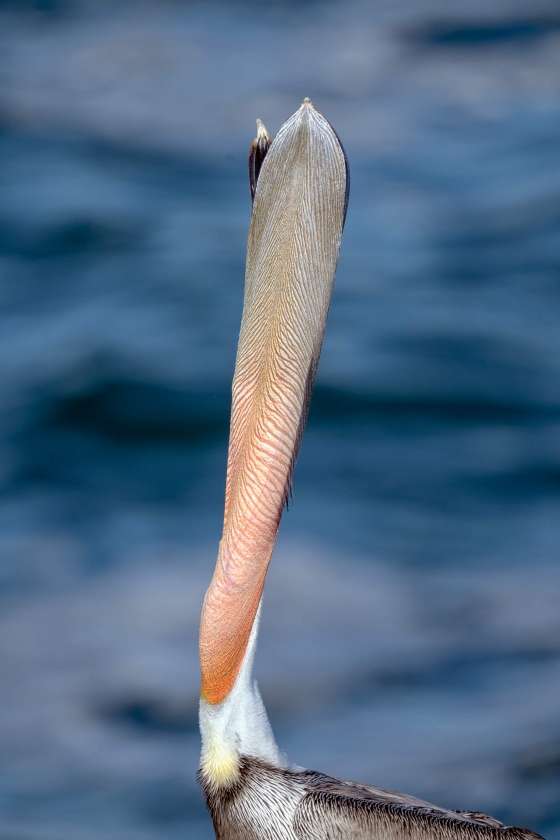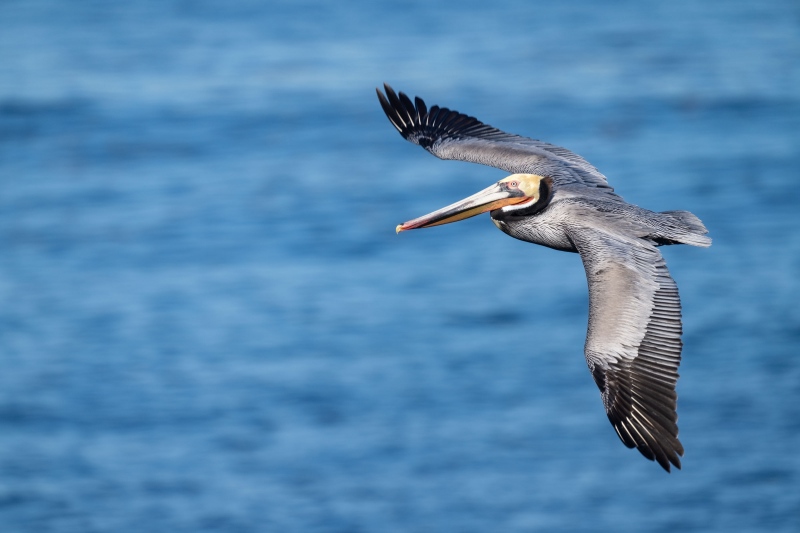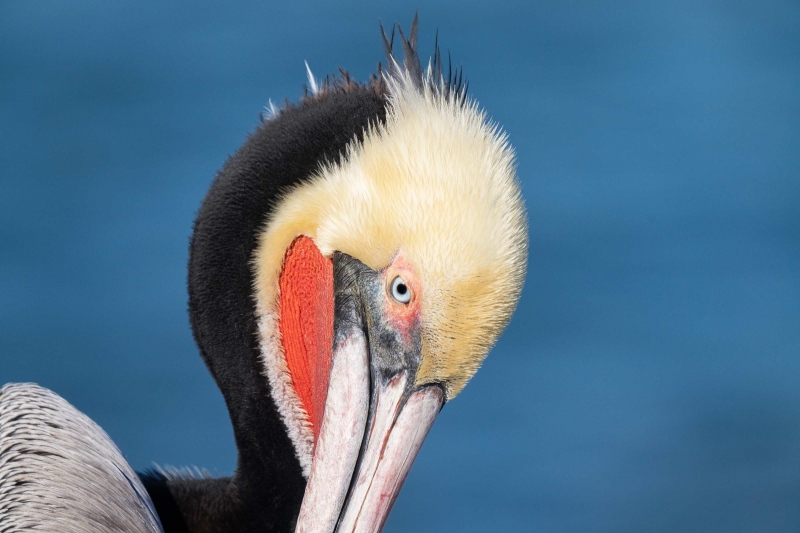Your Favorite?
Which of today’s four featured images is the strongest? Please leave a comment and let us know why you made your choice. I feel that two of the images are far stronger than the other two, and of those two, I have a very clear favorite. Comments on the two best are of course welcome.
What’s Up?
Well, nobody signed up for the Mini IPT. Yesterday, Monday, would have been Day 1. It turned out to be the best day of my trip so far. Where the lower shelf had been totally empty the day before, there were more than 100 pelicans packed onto just a small portion of the lower shelf. There were lots of chances for flight, and with so many birds so close together, lots of chances to isolate the subject, provided that you had the right rig in your hands.
New a1 Group member Kitty Kono sent me a quote that multiple IPT veteran and BAA-friend Larry Master posted to her hopping flicker image on her FB page here.
Larry wrote:
I bought an a1 and associated lenses a year ago. I love it, esp. with the 200-600 w/ 1.4, my standard set-up. I use all of Artie Morris’ settings, causing almost all images, esp. flight shots, to be razor sharp on the eye. And exposure is easily nailed using the control wheel to dial the ISO. I have never had such a great bird photography camera!
Though I have used the 1.4X TC with the 2-6, I had not really considered it for flight. So thanks, Larry, for your kind comment and for inspiring to try flight with the TC in place.
After early morning on the cliffs, I headed down the coast and look for pelicans skimming the waves. I was fairly successful, and was planning on doing ever better today (until I saw the weather forecast …)
I almost didn’t go out in the afternoon, but after checking the wind — strong from the south — I headed back to La Jolla and enjoyed some superb flight photography with the tripod-mounted 600mm f/4 lens with and without the 1.4X TC. Sunset looked promising at first, but fizzled (just as I ran out of space on my card). It was a fitting end to a great day.
Today is Tuesday 25 January 2022. The forecast is for today is for mostly to partly cloudy. That’s a bummer as I was getting used to the sun! Wherever you are, and whatever you are doing, I hope that you too have a great day. This blog post took about two hours to prepare and makes 74 days in a row with a new one.
Please remember that you can find some great photo accessories (and necessities, like surf booties!) on Amazon by clicking on the Stuff tab on the orange/yellow menu bar above. On a related note, it would be extremely helpful if blog-folks who, like me, spend too much money on Amazon, would get in the habit of clicking on the Amazon logo link on the right side of each blog post when they shop online. As you might expect, doing so will not cost you a single penny, but would be appreciated tremendously by yours truly. And doing so works seamlessly with your Amazon Prime account.
Please remember that if an item — a Delkin flash card, or a tripod head — for example, that is available from B&H and/or Bedfords, is also available in the BAA Online Store, it would be great, and greatly appreciated, if you would opt to purchase from us. We will match any price. Please remember also to use my B&H affiliate links or to earn 3% cash back at Bedfords by using the BIRDSASART discount code at checkout for your major gear purchases. Doing either often earns you free guides and/or discounts. And always earns my great appreciation.
SONY and artie
Switching to SONY, first with the a9 and the a9 II, and then to the remarkable a1, has enabled me (and others, like Mike De Rosa as seen a while ago in the blog post here), to create images of birds in flight and in action that I could never even dreamed of when using Canon for 33 years, and then Nikon for more than two. Most of the time I am using one of two AF methods that together, cover about 99% of the commonly-encountered bird photography situations. At present, I am experimenting beyond those … Learn more by joining the group! (I’ve recently switched to two other AF Methods!)
From long-time group member Craig Elson who has helped me often and immensely by answering some tough a1 questions, via e-mail
Artie, Thanks so much for consolidating and re-organizing all of the threads. I can only imagine how helpful this will be to someone opening the box on their new a1, not to mention your CAMSETA2.DAT file. And I think that was the first, and likely the last, time, that I will be referred to as “the estimable!”
From Long-ago IPT veteran Keith Kennedy via e-mail
Absolutely great information. I am calling Jim in a few minutes to order a couple of Delkin 128GB UHS-II cards. Your timely email has saved me a ton of money! Many thanks
In the same vein, via e-mail from John LeClair
Well, e-mail #21 alone was worth the price of admission!
From Pamela Viale, after receiving artie’s a1 settings along with detailed instructions on how to copy them to her SONY a1 via e-mail
This e-mail group has been an incredible boon to me! Thank you so much!
From Joe Barranco via e-Mail
Thanks for your great ideas on the A1 set up. I have been getting MANY more keepers doing things your way!
From Barbara White via e-Mail
Wow, I just gotta say – I learn so much from the SONY Alpha a1 Set-up and Info group! My camera is on my desk, and I’m always picking it up and changing something that I’ve read about in the e-mails.
Thanks, Barbara
From Janet Horton via e-Mail
Hi Artie, Mystery solved. Yes, I was able to replicate what you did. I forgot that you have to set self-timer using the upper dial. I am used to that being a MENU selection.
Thanks much, Janet
SONY Alpha a1 Set-up and Info Group
The SONY Alpha a1 Set-up and Info Group is going great guns as more and more folks chime in with thoughtful questions and experience-based answers. As the a1 is becoming more readily available, more and more folks are getting their hands on this amazing body. Last week, two folks in the group ordered a third a1! I am envious. The group is now up to an astounding 104 lucky and blessed folks. Early on, we discussed the myriad AF options. I gave my opinion as to the best one for flight and general bird photography. The best news is that all who wish, can request an e-mail that includes a .DAT file with my a1 settings on it, and explicit directions on how to load my settings onto your a1; talk about convenience! I am now offering a .DAT file compatible with firmware update 1.20. I finally finished the consolidated Sony a1 CAMSETA2 INFO & GUIDE and distributed it yesterday. New a1 folks will now receive three e-mails instead of the previous 28! It is a lot easier on me and is an incredible resource for folks new to the a1.
All who purchased their Alpha a1 bodies via a BAA affiliate link will receive a free subscription to the Sony Alpha a1 Set-Up and Info Updates group after shooting me their receipts via e-mail. (Note: it may take me several days to confirm B&H orders.) This same service may be purchased by anyone with an a1 body via a $150.00 PayPal sent to birdsasart@verizon.net indicating payment for Alpha a1 Info & Updates. Alternatively, folks can call Jim weekdays at 1-863-692-0906 to pay via credit card. New members will receive composite e-mails that summarize all previous discussions.
|
|
|
This image was created on 24 January 2022 at La Jolla, CA. I used the hand held Sony FE 600mm f/4 GM OSS lens with the Sony FE 1.4x Teleconverter (at 708mm) and The One, the Sony Alpha 1 Mirrorless digital camera. ISO 640. Exposure determined via Zebras with ISO on the Thumb Wheel: RawDigger showed that the raw file brightness was dead solid-perfect: 1/640 sec. at f/9 (wide open) in Manual mode. AWB at 9:14:17am on a clear sunny morning. Tracking: Spot S/AF-C with Bird-Eye/Face Detection performed perfectly. Be sure to click on the image to view the high-res version. Image #1: Brown Pelicans tandem bathing |
A Twenty-year Wait Ends: Right Time, Right Place, Right Rig!
The pelicans sometimes bathe in the ocean below the main cliffs. They are usually too far away. Or they are way off sun angle. Or I do not have a long enough lens. On Monday, after a 20-year wait, I had a good chance with a single bathing pelican at 8:12am. The dam had burst. More than an hour later, two pelicans landed very close to the cliffs and very close to being right on sun angle. Having the 1.4X TC on the 200-600 turned out to be perfect. Note here that I actually needed to zoom out a bit. Out of hundreds of images, I kept 24. This was my favorite of the bathing birds.
|
|
|
This image was created on 24 January 2022 at La Jolla, CA. I used the hand held Sony FE 600mm f/4 GM OSS lens with the Sony FE 1.4x Teleconverter (at 766mm) and The One, the Sony Alpha 1 Mirrorless digital camera. ISO 500. Exposure determined via Zebras with ISO on the Thumb Wheel: RawDigger showed that the raw file brightness was dead perfect: 1/1250 sec. at f/9 (wide open) in Manual mode. AWB at 9:30:54am on a clear sunny morning. Tracking: Center Zone/AF-C with Bird-Eye/Face Detection performed perfectly. Be sure to click on the image to view the high-res version. Image #2: Brown Pelican head throw — viewed from below |
Reach, Great AF, and Versatility
Sitting on my favorite perch above the pelicans, the 280-840mm combo gives me great reach, superb AF, the ability to isolate the subject, and the ability to zoom out from 840mm as needed (as with Images #1 and #2). Had I been at 600mm it would have been impossible to isolate the subject in Images #2 and #4. In short the 200-600/1.4X TC/a1 combo is beyond deadly on sunny days. Not to mention that it is hand holdable for most folks in reasonably good condition.
|
|
|
This image was created on 24 January 2022 at La Jolla, CA. I used the hand held Sony FE 600mm f/4 GM OSS lens with the Sony FE 1.4x Teleconverter (at 840mm) and The One, the Sony Alpha 1 Mirrorless digital camera. ISO 500. Exposure determined via Zebras with ISO on the Thumb Wheel: RawDigger showed that the exposure was about 1/3 stop under: 1/1250 sec. at f/9 (wide open) in Manual mode. AWB at 9:34:42am on a clear sunny morning. Tracking: Spot S/AF-C with Bird-Eye/Face Detection performed perfectly. Be sure to click on the image to view the high-res version. Image #3: Brown Pelican adult in flight at 840mm |
Hand Held Flight at 840mm?
A regular readers know, I cannot hand hold the 600mm f/4 GM lens for more than a few moments. Though it is the lightest and best balanced 600mm f/4 lens on the market, it is pretty much too heavy for me to hand hold it for more than a minute or two. Thanks again to Larry Master for inspiring me to try it for pelican flight. I was quite surprised that this image was critically sharp at “only” 1/1250 sec. I strive to do all of my flight photography with shutter speeds of at least 1/2500 sec. When this bird flew by, I followed my oft-given advice: shoot now and ask questions later. Had I tried to raise the shutter speed to 1/2000 sec. and increase the ISO to 800, I would have missed the shot.
In the same vein, Jordan Cait who has been doing a great job of proof-reading the blog recently, and teaching me some grammar as well, ends every-mail with this quote:
“You miss 100% of the shots you don’t take.” Wayne Gretzky, hockey legend.
|
|
|
This image was created on 24 January 2022 at La Jolla, CA. I used the hand held Sony FE 600mm f/4 GM OSS lens with the Sony FE 1.4x Teleconverter (at 840mm) and The One, the Sony Alpha 1 Mirrorless digital camera. ISO 1000. Exposure determined via Zebras with ISO on the Thumb Wheel: RawDigger showed that the exposure was dead-solid perfect: 1/1600 sec. at f/9 (wide open) in Manual mode. AWB at 9:42:57am on a clear sunny morning. Tracking: Spot S/AF-C with Bird-Eye/Face Detection performed perfectly. Be sure to click on the image to view the high-res version. Image #4: Brown Pelican in mega-breeding plumage/preening head portrait |
The Sweetest Backgrounds
When the distance from the subject to the background is constant, the longer the focal length, the sweeter the background. With image #4, I was working the closest pelican at 840mm; the bird was teed up on a rock about 15 feet from me. I was seated, so when I had the viewfinder to my eye, there were other pelicans in the background. Holding my rig just above the ground while working off the tilted rear monitor effectively moved the background farther from the bird, and eliminated the distracting elements at the bottom of the frame. The result? As clean, as soft, and as sweet a Pacific-blue background as you could ever dream of.
Typos
With all blog posts, feel free to e-mail or to leave a comment regarding any typos or errors.


















I like #2 but the dark line through the middle of the frame put me off. #4 is my favorite because it is razor sharp and has a nice even background.
Would pick #1. For colors, detail, action,etc,etc. Beautiful!
Artie
I am loving Image #1 and Image #2 (#3 & #4 are fairly common imo, may be wrong) But
Image #1 how many time have you ever got 2 bathing in frame at once the action is really cool.
I am however loving Image #2 the head throw is the coolest ever seeing the birds and how they interact and display and your image is spot on with the bill nicely in the frame for those that wouldn’t know by looking at it what it is one just looks at the beauty of the colors and it just all comes together. Really Beautiful and i feel the photo!
Always with love b